
Loriini is a tribe of small to medium-sized arboreal parrots characterized by their specialized brush-tipped tongues for feeding on nectar of various blossoms and soft fruits, preferably berries. The species form a monophyletic group within the parrot family Psittaculidae. The group consists of the lories and lorikeets. Traditionally, they were considered a separate subfamily (Loriinae) from the other subfamily (Psittacinae) based on the specialized characteristics, but recent molecular and morphological studies show that the group is positioned in the middle of various other groups. They are widely distributed throughout the Australasian region, including south-eastern Asia, Polynesia, Papua New Guinea, Timor Leste and Australia, and the majority have very brightly coloured plumage.

The common shelduck is a waterfowl species of the shelduck genus, Tadorna. It is widespread and common in the Euro-Siberian region of the Palearctic, mainly breeding in temperate and wintering in subtropical regions; in winter, it can also be found in the Maghreb.
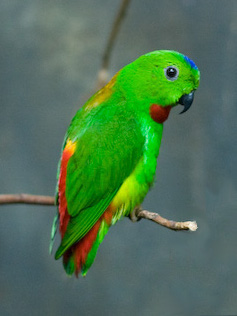
Hanging parrots are birds in the genus Loriculus, a group of small parrots from tropical southern Asia.

The blue-crowned hanging parrot is a parrot species endemic to southern Burma and Thailand, Malaya, Singapore, and Indonesia. These parrots are 12cm in height and weight 28g and have a longevity of 14 years. They are recognized by their green plumage, black beak and characteristic blue feathers arranged like a crown on their head.
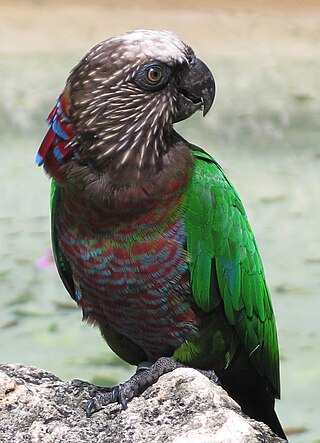
The red-fan parrot, also known as the hawk-headed parrot, is a New World parrot hailing from the Amazon Rainforest. It is the only member of the genus Deroptyus.

The yellow-shouldered amazon, also known as the yellow-shouldered parrot, is a parrot of the genus Amazona that is found in the arid areas of northern Venezuela, the Venezuelan islands of Margarita and La Blanquilla, and the island of Bonaire. It has been extirpated from Aruba and introduced to Curaçao.

The black-billed amazon is a parrot endemic to Jamaica. Sometimes called the black-billed parrot, this amazon parrot is mostly green with small patches of red on the wing and sometimes flecked on the head. Its bill makes it easy to separate from most other amazons, including the yellow-billed amazon, which also lives in Jamaica. It is the smallest Amazona parrot at 25 cm (10 in).

The Cuban amazon, also known as the Cuban parrot and the rose-throated parrot, is a medium-sized mainly green parrot found in woodlands and dry forests of Cuba, the Bahamas and Cayman Islands in the Caribbean. Although they have been observed in the wild in Puerto Rico, they are probably the result of escaped pets, and no reproduction has been recorded.

The lesser vasa parrot or black parrot is a black coloured parrot endemic to most of Madagascar. It is one of four species of vasa parrots, the others being the greater vasa parrot, the Seychelles black parrot, and the Comoros black parrot. The latter two were formerly considered conspecific with the lesser vasa parrot.

The red-lored amazon or red-lored parrot is a species of amazon parrot, native to tropical regions of the Americas, from eastern Mexico south to Ecuador where it occurs in humid evergreen to semi-deciduous forests up to 1,100 m altitude. It is absent from the Pacific side of Central America north of Costa Rica. Not originally known from El Salvador, a pair - perhaps escaped from captivity - nested successfully in 1995 and 1996 in the outskirts of San Salvador and the species might expand its range permanently into that country in the future. This species has also established feral populations in several California cities.

The chattering lory is a forest-dwelling parrot endemic to North Maluku, Indonesia. It is considered vulnerable, the main threat being from trapping for the cage-bird trade.

The purple-naped lory is a species of parrot in the family Psittaculidae. It is forest-dwelling endemic to the islands of Seram, Ambon, and perhaps also Haruku and Saparua, South Maluku, Indonesia. It is considered endangered, the main threat being from trapping for the cage-bird trade.
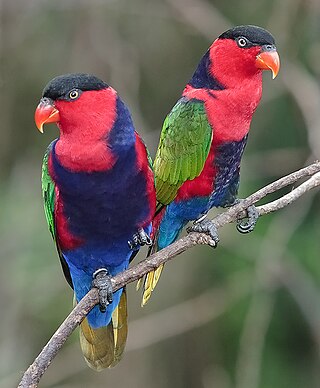
The black-capped lory also known as western black-capped lory or the tricolored lory, is a parrot found in New Guinea and adjacent smaller islands. It is a colourful and relatively robust lory. There are seven subspecies, all with green wings, red heads and body around the wing, a black cap, grey-black cere, yellow underwings, and blue legs and belly. Most also have a blue nape and mantle. It remains overall widespread and common, but the subspecies cyanuchen is relatively rare, with fewer than 5,000 individuals remaining.

Brotogeris is a genus of small parrots endemic to Central and South America. Their closest relatives are the monk parakeet and the cliff parakeet in the genus Myiopsitta. They eat seeds and fruit. The word brotogeris means "having the voice of a human". In the language of their native countries, which is mostly Spanish, they are called pericos – the translation of which is "parakeet". Their average lifespan is 15 years, although some have been reported to have lived up to 35 years. Also, the bird was found in Rio Grande do Sul in South America.

The plain parakeet is a species of bird in subfamily Arinae of the family Psittacidae, the African and New World parrots. It is endemic to Brazil.

The brown lory, also called Duyvenbode's lory, is a species of parrot in the family Psittaculidae native to northern New Guinea.

The red lory is a species of parrot in the family Psittaculidae. It is the second-most commonly kept lory in captivity, after the rainbow lorikeet.
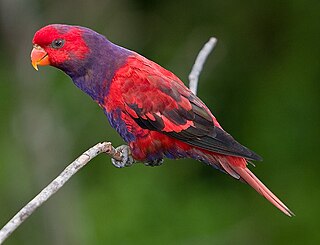
The violet-necked lory is a species of parrot in the family Psittaculidae. It is endemic to Indonesia, where it is found in the northern Maluku Islands and west Papuan islands. Its natural habitats are tropical moist lowland forests and tropical mangrove forests.

The ornate lorikeet, sometimes named the ornate lory, is a species of parrot in the family Psittaculidae. It is endemic to the Sulawesi archipelago in Indonesia. It is found in forest, woodland, mangrove and plantations, and is locally common.
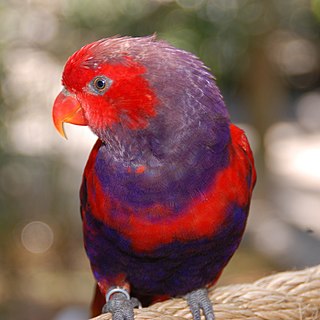
Eos is a genus of parrots belonging to the lories and lorikeets tribe of the family Psittaculidae. There are six species which are all endemic to islands of eastern Indonesia, most within very restricted ranges. They have predominantly red plumage with blue, purple or black markings. Males and females are similar in appearance.

























